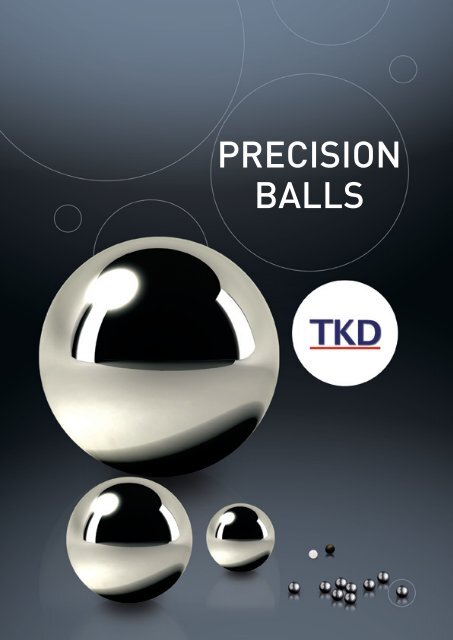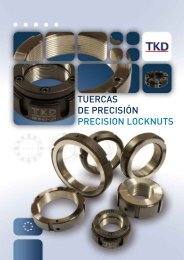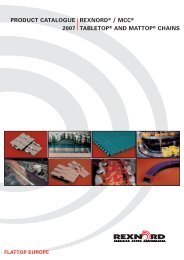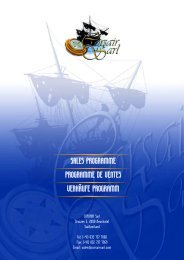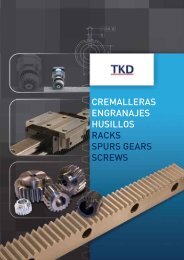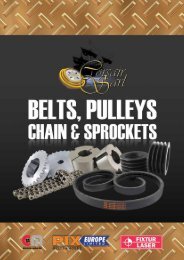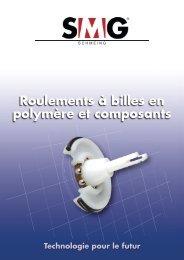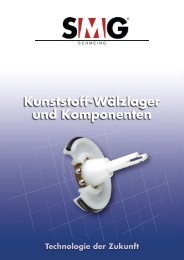TKD Precision Balls - Corsairsarl.com
TKD Precision Balls - Corsairsarl.com
TKD Precision Balls - Corsairsarl.com
You also want an ePaper? Increase the reach of your titles
YUMPU automatically turns print PDFs into web optimized ePapers that Google loves.
PRECISIONBALLS
DIMENSIONAL AND CONTOUR ACCURACYACCORDING TO DIN 5401GradeNominalsizeDw tDws IGLimitingdimensionsVDws Ra VDwL VDwA STClassification range and gradingmm µm µm µm µm µm µm µmabove up to max max max maxG3 - 12,7 ± 5,32 0,08 0,01 0,13 - 0,5 -5 to -0,5 0 0,5 to 5G5 - 12,7 ± 5,63 0,13 0,014 0,25 - 1 -5 to -1 0 1 to 5G10 - 25,4 ± 9,75 0,25 0,02 0,5 - 1 -9 to -1 0 1 to 9G16 a - 25,4 ± 11,4 0,4 0,025 0,8 - 2 -10 to -2 0 2 to 10G20 a - 38,1 ± 11,5 0,5 0,032 1 - 2 -10 to -2 0 2 to 10G28 a - 50,8 ± 13,7 0,7 0,05 1,4 - 2 -12 to -2 0 2 to 12G40 - 100 ± 19 1 0,06 2 - 4 -16 to -4 0 4 to 16G80 b - 100 ± 14 2 0,1 - 4.0 4 -12 to -4 0 4 to 12G100 - 150 ± 47,5 2,5 0,1 5 - 10 -40 to -10 0 10 to 40G200 - 150 ± 72,5 5 0,15 10 - 10 -60 to -10 0 10 to 60G300 a - 25,4 ± 70 10 0,2 - 20 20 -60 to -20 0 20 to 60G300 c 25,4 50,8 ± 105 15 0,2 - 30 30 -90 to -30 0 30 to 90G300 50,8 75 ± 140 20 0,2 - 40 40 -120 to -40 0 40 to 120G500 d - 25,4 ± 75 25 - - 50 50 -50 0 50G500 25,4 50,8 ± 112,5 25 - - 75 75 -75 0 75G500 50,8 75 ± 150 25 - - 100 100 -100 0 100G500 75 100 ± 187,5 32 - - 125 125 -125 0 125G500 100 125 ± 225 38 - - 150 150 -150 0 150G500 125 150 ± 262,5 44 - - 175 175 -175 0 175G600 d all ± 200 - - - 400 - - 0 -G700 d all ± 1000 - - - 2000 - - 0 -a By agreement with the manufacturer you can get half the sort interval values for classes G16, G20, G28 and G300 in special circumstances.b Not defined in ISO 3290, class is equivalent to the former class IV according to DIN 5401:1978-01.c Not defined in ISO 3290, class is equivalent to the standard accuracy for unhardened rustless balls according to DIN 5401-2: 1993-11.d Not defined in ISO 3290, classes are equivalent to the former classes V to VII according to DIN 5401:1978-01.5
MATERIAL COMPARISON CHARTWaterInorganic salt solutionsWeak acidsStrong inorganic acidsStrong acidsHydrofluoric acidOxidising acidsWeakly alkaline solutionsStrongly alkaline solutionsAliphatic hydrocarbonsAromatic hydrocarbonsChlorinated hydrocarbonsUnsaturated chlorinated hydrocarbonsLow MW alcoholsEstersKetonesEthersGasolineFuel mixturesMineral oilGreases, oilsTurpentine1.0616 hardened D D D D D D D C A B B A A B A A B B B B B A1.3505 hardened D D C D D D D A A B B A A B A A B B B B B A1.4034 hardened B D D C D D C A D B B A D B B B B B B B B B1.4125 hardened B D D A D D B A A A B A D B B B B B B B B B1.4301 B A A A A A A A A B B E D B B B B B B B B B1.4401 B B A A A A A A A A B B D B B B B B B B B B1.4571 B B A A A A A A A B B B D B B B B B B B B BTitanium 35 B A A E A D A B E B B B B B B B B B B B B BAluminium B E A E C D A E C B B A A B B B B B B B B BHard metal B A D C D D D D C B B B B B B B B B B B E BBrass A C D C D C D A A E E E B E B B B B B B B BBronze B C A A C A D A D B B B B B B B B B B B B BSteatite B E B B A D B B A B B B B B B B B B B B B BGlass B B B E E D B B E B E B B B B B B B B B B BPA 66 E B D C D D D E A B B C E B B B B B E B B APOM E B C E D D D B B B E B B B D A B E B B B APP B B B B D A D B B B C D D B A B A C C A E DPTFE B B B B B E B B B B B B B B B B B B B B B BPUR A D D D D D D D D D D D A A D D B B DCeramic (Si3N4) B B B E E C A B A B B B B B B B B B B B B BZirconium oxide ZrO 2B B B B B C B B B B B B B B B B B B B B B BAluminium oxide Al 2O 3B B B B B C B B A B B B B B B A B B B B B BB resistant E adequate resistance A limited resistanceC generally non-resistant D <strong>com</strong>pletely non-resistant6
BALLS DIN 5401: 2002-08 OF STEEL MATERIALSThe below mentioned data sheets inform you about the approximate weights per 1.000 ballsconcerning the materials 1.0010, 1.0413, 1.0616, 1.3505, 1.3520, 1.4034, 1.4301 and 1.4125.mm inch kg/1.000 balls0,400 – 0,000250,500 – 0,000500,600 – 0,000870,635 – 0,001030,700 – 0,001380,800 – 0,002061,000 – 0,004091,200 – 0,006961,500 – 0,013871,588 116 0,016462,000 – 0,032882,381 332 0,055482,500 – 0,064222,778 764 0,088123,000 – 0,11103,175 18 0,13163,500 – 0,17623,969 532 0,25704,000 – 0,26314,500 – 0,37454,762 316 0,44395,000 – 0,51385,500 – 0,68385,556 732 0,70496,000 – 0,88786,350 14 1,0526,500 – 1,1297,000 – 1,4107,144 932 1,4997,500 – 1,7347,938516 2,0568,000 – 2,1048,500 – 2,5248,731 1132 2,7369,000 – 2,9969,52538 3,55210,000 – 4,11010,319 1332 4,51611,000 – 5,47111,112 716 5,6408mm inch kg/1.000 ballsmm inch kg/1.000 balls39,688 1 9 16 256,948 127,000 – 8419,411,500 – 6,25140,000 – 263,05611,906 1532 6,93741,275 1 5 8 289,02112,000 – 7,10342,862 1 11 16 323,65712,700 12 8,41944,450 1 3 4 360,98013,000 – 9,03045,000 – 374,54713,494 1732 10,09946,038 1 13 16 401,06814,000 – 11,27947,625 1 7 8 443,99014,288 916 11,98949,212 1 15 16 489,87115,000 – 13,87250,000 – 513,78115,081 – 14,09850,800 2 538,83915,875 – 16,44452,388 2 1 16 590,96816,000 – 16,83653,975 2 1 8 646,31817,000 – 20,19455,000 – 683,84317,462 1116 21,88557,150 2 1 4 767,21518,000 – 23,97160,000 – 887,819,000 – 28,19260,325 2 3 8 902,319,05034 28,41561,912 2 7 16 975,419,844 2532 32,11963,500 2 1 2 1052,420,000 – 32,88265,000 – 1128,821,000 – 38,06566,675 2 5 8 1218,322,000 – 43,76669,850 2 3 4 1400,822,22578 45,12373,025 2 7 8 1600,623,000 – 50,00975,000 – 1734,024,000 – 56,82076,200 3 1818,625,000 – 64,22379,375 3 1 8 2055,525,400 1 67,35580,000 – 2104,426,000 – 72,24282,550 3 1 4 2312,227,781 1 3 32 88,12885,725 3 3 8 2589,428,000 – 90,22888,900 3 1 2 2887,830,000 – 110,97790,000 – 2996,431,750 1 1 4 131,55392,075 3 5 8 3208,432,000 – 134,68595,250 3 3 4 3551,932,544 1 9 32 141,67198,425 3 7 8 3919,133,338 1 5 16 152,295100,000 – 4110,334,000 – 161,549101,600 4 4310,734,925 1 3 8 175,097104,775 4 1 8 4727,635,000 – 176,227107,950 4 1 4 5170,535,719 1 13 32 187,312108,000 – 5177,736,000 – 191,768110,000 – 5470,736,512 1 7 16 200,067111,125 4 3 8 5640,338,000 – 225,538114,300 4 1 2 6137,738,100 1 1 2 227,323120,000 – 7102,5150,000 – 13872,1
BALLS DIN 5401: 2002-08 TUNGSTEN CARBIDEThis data sheets show you the weights per 1.000 balls regarding the material tungsten carbide.mm inch kg/1.000 balls0,400 – 0,000500,500 – 0,00097mm inch kg/1.000 balls4,000 – 0,49834,500 – 0,70950,600 – 0,001684,762316 0,84080,635 – 0,001990,700 – 0,002675,000 – 0,97325,500 – 1,29540,800 – 0,003995,556732 1,33541,000 – 0,007796,000 – 1,68181,200 – 0,013456,35014 1,9941,500 – 0,026286,500 – 2,1381,588116 0,031187,000 – 2,6712,000 – 0,062297,144932 2,8392,381332 0,105107,500 – 3,2852,500 – 0,121657,938516 3,8942,778764 0,166928,000 – 3,9863,000 – 0,21028,500 – 4,7823,17518 0,24928,7311132 5,1823,500 – 0,33389,000 – 5,6763,969532 0,48689,52538 6,72810,000 – 7,786CONVERSION FORMULA KG/1.000 PIECESIf you want to calculate the exact weight in kg per 1.000 balls then please be so kind to use the following conversionformula:DIAMETER³ x 3,14 / 6 x Specific Weight or Gravity / 1000SURFACE ROUGNESS<strong>Balls</strong> up to diameter 1,200 mm and in Material TC can be supplied in different roughnessS1S2S3S50,000µm - 0,010µm0,011µm - 0,020µm0,021µm - 0,030µm> 0,030µm9
PLASTIC BALLSPlastic balls are produced using standard and special polymerresins with diameters from 1.50 to 150 mm. and they can beused instead of stainless steel or steel balls in various industrialapplications at lower cost than metal balls.Plastic balls offer above all the advantage of being very light,since their specific weight is very low. They are also highlyresistant to heat and they provide smooth and silent running,totally noise and friction free. Unlike conventional metal ballsthey do not require lubrication.Another important feature is their excellent resistance tooxidation and abrasion and, therefore the use of these balls,even in very corrosive environments, allows long life of the<strong>com</strong>ponent concerned. They also provide electrical and heatinsulation and are not magnetic. The most suitable type ofsynthetic material can be chosen from a wide range of plasticseach with different characteristics.The most <strong>com</strong>mon applications include plastic bearingsand rollers, ball bearings for furniture, micro-pumps forsprays, dispensers, pumps and valves, precision instruments,measurement and control equipment, photographic andpharmaceutical equipment, <strong>com</strong>puters, conditioning andautomation equipment, photocopiers and equipment for theindustry.NYLON (PA)Insoluble in <strong>com</strong>mon solvents, alcalis, diluted mineral acids and organicacid substances. It is, above all, resistant to alcalis, oils and petroleumgreases at temperatures up to 150 °C, inorganic saline solutions, aromatichydrocarbons, low strength alcohols, gasoline. It has high strength, rigidityand hardness characteristics.DELRIN (ACETAL RESIN - POM)Polymer resin with excellent mechanical and chemical resistance andgood electrical properties. Resistant to inorganic saline solutions,aliphatic, aromatic and chlorinated hydrocarbons, low strength alcohols,ether, <strong>com</strong>bustible mixtures, mineral oils and greases. <strong>Balls</strong> made ofthese materials are often used for sliding fittings of tables and drawers,furniture bearings, rollers, valves and electronic <strong>com</strong>ponents, sailing boatfittings.POLYPROPYLENE (PP)Excellent chemical resistance, low specific weight (less than water) andthe highest melting point of thermoplastics. It is an excellent electricalinsulator and has a low dielectric constant coefficient. It is often usedwhere the capacity to float on fluids in general is required. It is ideal forequipment used for blood transfusions, level indicators and deodorantroll-on sticks. It is highly resistant to chemical substances, such asacids, alcalis, alcohols and many inorganic substances, saline solutions,solvents, alcohols, gasoline (petrol), water, oils, greases, detergent, fruitjuices and milk. It is not resistant to aromatic hydrocarbons and chlorates.It is perfect for all medical and pharmaceutical applications.On request, we can supply further materials of plastic balls and glass fibres filled balls.SpecificationSpecificgravityHardnessSHORENormalconditionMax tempresitance ºCWaterabsorptionColdresistanceColourCharacteristicsNYLON (PA) 1.13 80 (D) 100º C 120º C 3% very good white Low cost plastic balls used in bearings,valves, etc. resitent to alkalis andpetroleum products and most mildchernicals.DELRIN (ACETALRESIN - POM)1.45 80 (D) 100º C 140º C minimum up to-40º Cwhite Similar to polymide but slightlyharder and denser and with low waterabsorption.POLYPROPYLE-NE (PP)0.92 80 (D) 80º C 100º C minimum very good ivory Low weight and low water absorptionused in fluid level gauges, flowmetersand valves where these propertiesare required with good corrosionresitance.Grade Sphericity Tolerance SurfaceInches mm Inches mmI 0.0005 0.0125 +/-0.001 0.025 PolishedII 0.001 0.025 +/-0.002 0.050 Polished andunpolishedIII 0.005 0.125 +/-0.005 0.125 Unpolished10
CERAMIC BALLSCeramic balls are widely used in strong conditons. Ceramic have a lower density than steel, a low coefficient of termalexpansion and a very high hardness. They have a long life in very high velocitiy applications. The most importantmaterials are Silicion Nitrid, Alumina Oxide and Zirconium Oxide.Si 3N 4SILICON NITRIDEThe most widely used type of ceramic due to very high resistance to wear and abrasion in general. It has a low coefficientof thermal expansion (25% of that of steel balls) and a weight 60% lower than steel. It has a micro-structure speciallydesigned for applications subject to great stress. It does not require lubrication, it is resistant to corrosion, antimagneticand electrically insulating, and it continues to be efficient at high temperatures up to +1400 °C. It <strong>com</strong>binesextreme hardness with a high precision ball. Si3N4 balls are widely used in high precision bearings in the airspaceindustry, for machine tools, measurement instruments, valves for automotive technique, <strong>com</strong>pressors and fast turninghard disc.AL 2O 3ALUMINIA OXIDEAlumina Oxide balls are particularly well suited for use in extremely harsh environments where high temperatures,corrosive and erosive substances are present. Standard 99.5% alumina oxide ceramic balls have proven performancein wear, heat and corrosive environments, as well as, in maintaining dimensional stability at temperatures up to2000°F.Alumina resists oxidation and is tolerant to water, salt solutions, and many chemicals and acids, but is not suitable foruse in hydrochloric or hydrofluoric acids or strong alkaline solutions. Typical applications include pumps, valves andflow metersZr0 2ZIRCONIUM OXIDEThis material, <strong>com</strong>pared has a high degree of <strong>com</strong>pactness and considerable flexural strength, which makes it veryreliable. It also has a low modulus of elasticity, close to that of steel, together with an extraordinarily low thermalconductivity.Ceramic TypeALUMINIA OXIDEZIRCONIUM OXIDEChemical<strong>com</strong>positionDensityHardenessMax. operatingtemperature99,5% AL 2 O 33,90 g/cm³ 1700 HV 1750ºC/3182ºF5% Other97% ZrO 25,50 g/cm³ 800 HV 1100ºC/2012ºF3% MgOCorrosionresistanceInvert to most acids, but notrec<strong>com</strong>ended in envionmments withsulphuric or hydrofluoric acids orstrong solutions.Inert except to hydrofluoric acid andstrong concentrations of sulphuricacid.SILICON NITRIDE87% SI 3 N 43,20 g/cm³ 1700 HV 1000ºC/1832ºF Inert to most acids13% Other11
Bilbao / BilboSalida nº 13autopista A-8ItziarElgoibarBiarritzDonostiaSan SebastiánMondragónVitoria / GasteizIruña / Pamplona// HEAD OFFICETECNOMECA-KIDELAN, S.A.U.Address: Pol. Industrial Itziar,Parcela J-120.829 Deba (Gipuzkoa)Contact: Tel.: +34 943 199 201Fax: +34 943 199 273E-mail: tecnomeca@tecnomeca.<strong>com</strong>Web: http://www.tecnomeca-kidelan.<strong>com</strong>// SALES OFFICE EUROPETECNOMECA-KIDELANAddress: Heidt 1E42499 Hueckeswagen (Germany)Contact: Tel.: +49 2192 936993Fax: +49 2192 936992E-mail: info@tecnomeca.deWeb: http://www.tecnomeca-kidelan.<strong>com</strong>


